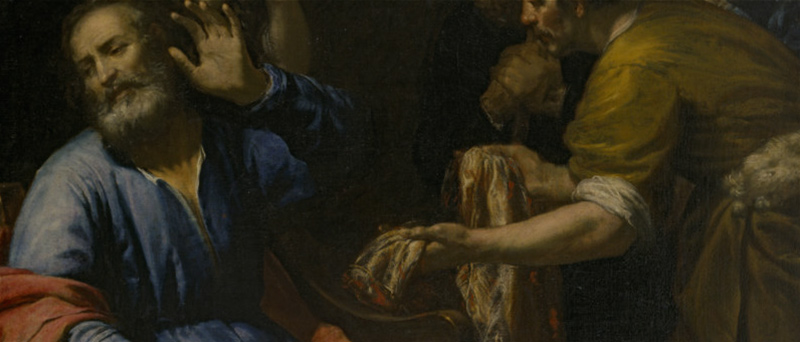
The following post is taking from my book Embodied: Transgender Identities, the Church, and What the Bible Has to Say, chapters 5 and 6.
The story of Joseph (Gen. 37-50) is regularly retold in Sunday schools and synagogues alike, but one interpretive possibility you might not have grown up with is—Joseph might have been trans*. This might sound outlandish, or perhaps encouraging, depending on where you’re standing. Before jumping to conclusions, though, we should all ask: is there anything in the text which suggests that Joseph might have been trans*? Yes, there might be.
This interpretation is based on the curious meaning of Joseph’s coat. It’s well known that Jacob gave Joseph a “tunic of many colors” (Gen. 37:3 NKJV) or an “ornate robe” as the NIV puts it. The Hebrew meaning of Joseph’s coat, ketonet passim in the Hebrew, is actually uncertain. It could mean “tunic of many colors” or it also mean “long tunic with long sleeves.” The only other time we see such a coat—and this is where it gets interesting—is on a woman, Tamar, who “was wearing a long robe with sleeves (ketonet passim), for thus were the virgin daughters of the king dressed” (2 Sam. 13:18 ESV). Some people therefore say that Joseph’s coat is evidence he was cross-dressing or trans*, possibly both.
Linda Tatro Herzer, for instance, says that Joseph was “gender variant” because he wore a “girly garment gladly” (The Bible and the Transgender Experience, 89).Another writer says that Joseph’s coat “opens the possibility that Joseph could have been, instead of an arrogant little twerp spoiled by his father, a transgender kid just trying to survive in the family.” And another says: “Joseph wasn’t wearing a rainbow coat. He was wearing a princess coat…Joseph is a flaming young queen.”
So what are we to make of this? Is Joseph’s coat evidence that he might have been trans*? I’m a big fan of giving every interpretation a fair shake if there’s evidence to support it. But I do find this reading to be problematic for several reasons. First, we only have two occurrences of the Hebrew phrase ketonet passim in Scripture, which makes it difficult to know whether Joseph was wearing a women’s tunic, or whether Tamar and the virgin daughters were wearing men’s tunics, or whether they were both wearing a unique kind of garment that was gender neutral—perhaps some kind of royal garment worn by both men and women (see below). Second, keep in mind that Tamar lived one thousand years after Joseph. Was the ketonet passim even the same kind of coat after all those years? Third, Jacob gave Joseph the coat. Whatever it looked like, it was a gift of honor. It’s not like Joseph went out to some ancient H&M, passed over all the male coats, and picked out a women’s coat. As OT scholar Gordon Wenham says, “[W]hatever the tunic looked like, it marked Jacob’s special affection for Joseph and served as a perpetual reminder to his brothers” (Genesis 16–50, Word Biblical Commentary, vol. 2 [Nashville: Thomas Nelson, 1987], 351). This would be an odd display of “special affection” if Jacob stuffed Joseph into a girl’s coat in a society where he would have been ridiculed for it. Fourth, and moreover, his brothers didn’t tease him for wearing the coat. Instead, they were jealous. I find it unlikely that all of Joseph’s brothers were aspiring cross-dressers.
Buy Now!
Embodied: The Latest from Preston Sprinkle
Clearly, Jacob was bestowing favor on Joseph via the coat. And parallels to ketonet passim in other ancient languages suggest that the coat might have symbolized some kind of royal status or favor, which, from a literary perspective, would foreshadow Joseph’s rise to power at the end of the narrative—something revealed to Joseph in his dream right after he received his coat (Gen. 37:5-8). I don’t find it convincing that the uncertain meaning of ketonet passim gives us a clear window into Joseph’s “internal sense of self” (gender identity).
As I step back and think about the logic of this interpretation, I’m probably more concerned about the role that gender stereotypes play in this interpretation than I am about the interpretation itself. Herzer, quoted above, goes on to identify several biblical characters who were, in her words, “gender variant”—a phrase she uses throughout her book to suggest that “male and female were not the only two realities” (pg. 47). Not only is Joseph “gender variant” (not fully male or female) because he wore a “girly garment gladly” (pg. 89), but Jacob too “was definitely gender variant ... given his preference for women’s work and for spending his days among the women of his tribe” (pg. 84).And Deborah (Judges 4-5) was not “strictly male or female” since she was “settling disputes, speaking on God’s behalf, leading an army”—things that “were all strictly men’s work” (pg. 92).
Aside from confusing the concepts of sex and gender, I appreciate how Herzer shows that various biblical characters didn’t fit the masculine and feminine stereotypes of the day. However, I’m nervous about the ontological implications of her claims. In trying to push back against stereotypes, Herzer ends up affirming them. Phrases like “women’s work” and “girly garment” supports the cultural stereotypes of what it means to be a man or a woman. Again, “gender variant” for Herzer and others means not entirely male or female, so if a male acts in less-than-masculine ways, then this shows they’re not entirely male. But if Jacob chooses to do “women’s work” (Herzer’s phrase, not mine), does this mean he’s not fully male? Do we have to question whether Deborah was fully female since she was capable of “setting disputes”? When Joseph donned his colorful coat, was it because he was trans*? Or just a man with fabulous taste?
Sure, the Jewish and Greco-Roman cultures of biblical times were saturated with expectations about how women and men should act. Some of these stereotypes are very similar to the ones we have today. Men were expected to be hairy-chested, sexually charged, domineering men. And real men were military men. Joining the military and becoming a soldier “was the only way many Roman males could lay claim to being a man” (McDonnell, Roman Manliness, 10-11). Any male who cried in public, showed affection (not just lust) toward women, abstained from sex outside of marriage, or honored lower-class people—the poor, the marginalized, and children—was not considered a real masculine man. A “real man,” according to the culture, would never have washed another man’s feet.
Enter Jesus.
Jesus not only turned over tables in the temple but also overturned social views about masculinity and femininity. In addition to his “masculine” table-flipping, Jesus also wept over Jerusalem and longed to “gather your children together, as a hen gathers her chicks under her wings” (Luke 13:34). He also let others slap him in the face and smack him on the head, and he rarely stood up for his personal rights. Jesus comes to us as one who “challenges cultural notions of masculinity. He washes feet, touches sick people, shows compassion to sinful women, loves children, and more.” (Cortez, ReSourcing Theological Anthropology, 203). Jesus, in other words, supplies us with a countercultural view of masculinity. This doesn’t mean that “male and female” are only two of many options. It shows, rather, that being male and female is much more expansive than what our culture wants to allow. And when we say that biblical characters—or people today—who don’t conform to stereotypes aren’t fully male or female, we essentially validate the very stereotypes we think we’re critiquing.
Let Joseph wear his fabulous coat with gladness without questioning his gender. Because cultural assumptions about masculinity do not determine whether you are a man.

